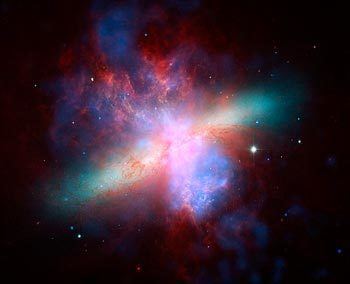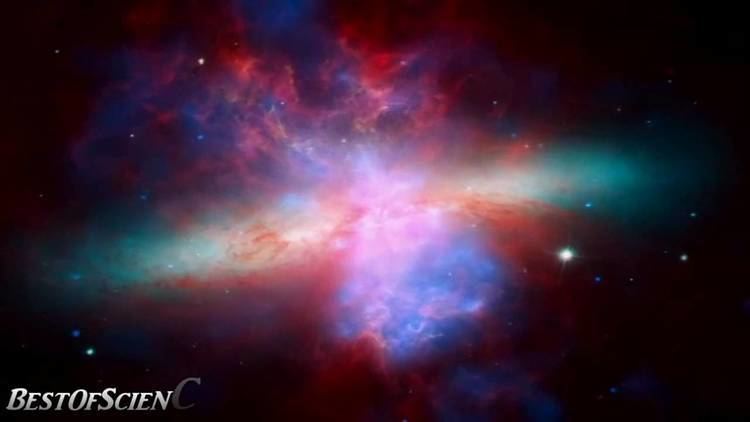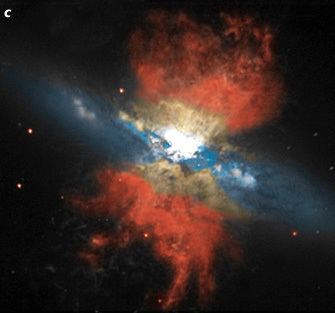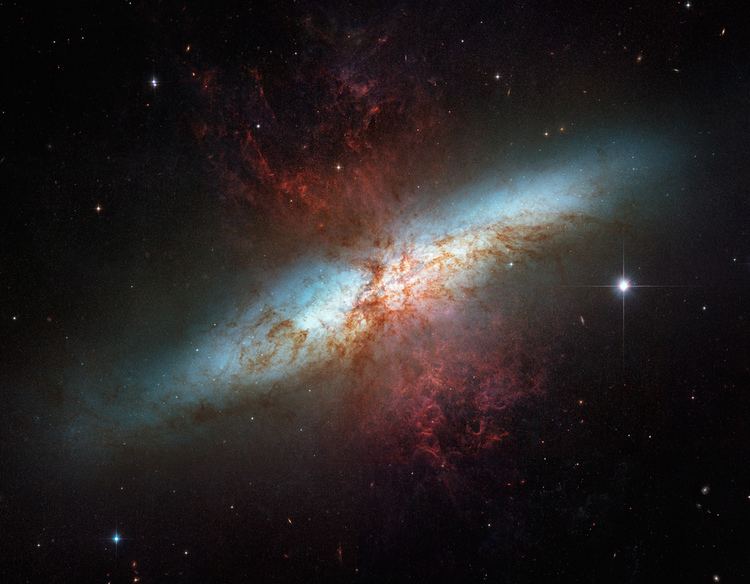 | ||
Similar | ||
A nearby starburst galaxy
A starburst galaxy is a galaxy undergoing an exceptionally high rate of star formation, as compared to the long-term average rate of star formation in the galaxy or the star formation rate observed in most other galaxies. In a starburst galaxy, the rate of star formation is so large that the galaxy will consume all of its gas reservoir, from which the stars are forming, on a timescale much shorter than the age of the galaxy. As such, the starburst nature of a galaxy is a phase, and one that typically occupies a brief period of a galaxy's evolution. The majority of starburst galaxies are in the midst of a merger or close encounter with another galaxy. Starburst galaxies include M82, NGC 4038/NGC 4039 (the Antennae Galaxies), and IC 10.
Contents
- A nearby starburst galaxy
- Starburst galaxy surprises astronomers space news
- Definition
- Triggering mechanisms
- Types
- Ingredients
- Examples
- References

Starburst galaxy surprises astronomers space news
Definition
Starburst galaxies are defined by these three interrelated factors:

- The rate at which the galaxy is currently converting gas into stars (the star-formation rate, or SFR).
- The available quantity of gas from which stars can be formed.
- A comparison of the timescale on which star formation will consume the available gas with the age or rotation period of the galaxy.
Commonly used definitions include:

Triggering mechanisms
Starburst galaxies feature a large amount of cool molecular gas in a small volume. Galaxies in the midst of a starburst also frequently show tidal tails, an indication of a close encounter with another galaxy, or are in the midst of a merger. Interactions between galaxies that do not merge can trigger unstable rotation modes, such as the bar instability, which causes gas to be funneled towards the nucleus and ignites bursts of star formation near the galactic nucleus.
Types
Classifying types of starburst galaxies is difficult since starburst galaxies do not represent a specific type in and of themselves. Starbursts can occur in disk galaxies, and irregular galaxies often exhibit knots of starburst spread throughout the irregular galaxy. Nevertheless, astronomers typically classify starburst galaxies based on their most distinct observational characteristics. Some of the categorizations include:
Ingredients
Firstly, a starburst galaxy must have a large supply of gas available to form stars. The burst itself may be triggered by a close encounter with another galaxy (such as M81/M82), a collision with another galaxy (such as the Antennae), or by another process which forces material into the centre of the galaxy (such as a stellar bar).
The inside of the starburst is quite an extreme environment. The large amounts of gas mean that very massive stars are formed. Young, hot stars ionize the gas (mainly hydrogen) around them, creating H II regions. Groups of very hot stars are known as OB associations. These stars burn very bright and very fast, and are quite likely to explode at the end of their lives as supernovae.
After the supernova explosion, the ejected material expands and becomes a supernova remnant. These remnants interact with the surrounding environment within the starburst (the interstellar medium) and can be the site of naturally occurring masers.
Studying nearby starburst galaxies can help us determine the history of galaxy formation and evolution. Large numbers of the very distant galaxies seen, for example, in the Hubble Deep Field are known to be starbursts, but they are too far away to be studied in any detail. Observing nearby examples and exploring their characteristics can give us an idea of what was happening in the early universe as the light we see from these distant galaxies left them when the universe was much younger (see redshift). However, starburst galaxies seem to be quite rare in our local universe, and are more common further away - indicating that there were more of them billions of years ago. All galaxies were closer together then, and therefore more likely to be influenced by each other's gravity. More frequent encounters produced more starbursts as galactic forms evolved with the expanding universe.
Examples
M82 is the archetypal starburst galaxy. Its high level of star formation is due to a close encounter with the nearby spiral M81. Maps of the regions made with radio telescopes show large streams of neutral hydrogen connecting the two galaxies, also as a result of the encounter. Radio images of the central regions of M82 also show a large number of young supernova remnants, left behind when the more massive stars created in the starburst came to the end of their lives. The Antennae is another starburst system, detailed by a Hubble picture, released in 1997.
